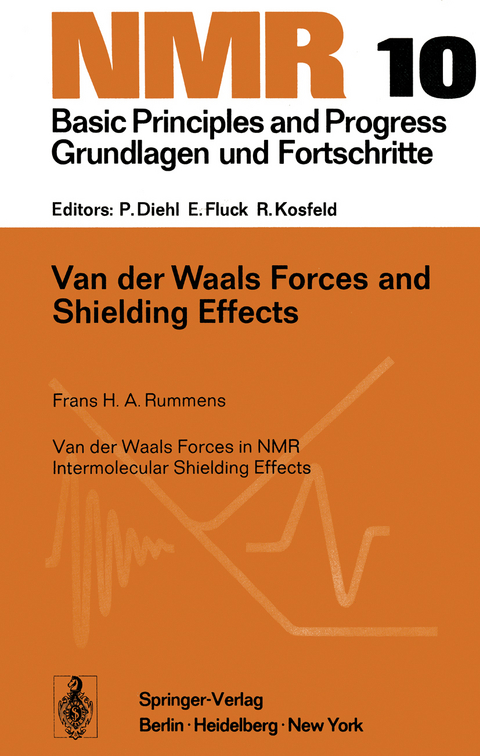
Van der Waals Forces and Shielding Effects
Springer Berlin (Verlag)
978-3-642-66178-5 (ISBN)
and Foreword.- 1. Historical Development (Up to 1961).- 2. Continuum Models.- 2.1. The Continuum Model of Linder.- 2.2. The Continuum Model of De Montgolfier.- 2.3. The McRae Formula.- 3. Pair Interaction Models ?w.- 3.1. The Binary Collision Gas Model of Raynes, Buckingham and Bernstein.- 3.2. The Cage Model.- 3.3. Kromhout and Linder's Quantum Mechanical Model.- 3.4. A Preliminary Comparison of the Various Models Suggested for ?w.- 4. Other Experimental Proton ?w Data.- 5. The Physical Nature of the Field $$ overline {{F^{2}}} $$ and of the Associated Excitation Energy.- 5.1. The Bothner-By Method.- 5.2. The Raynes-Buckingham-Bernstein (RBB) Method.- 5.3. Linder's Model.- 5.4. De Montgolfier's Method.- 5.5. The Method of Kromhout and Linder.- 5.6. An Empirical Test.- 6. The Site Factor.- 6.1. The Solute Site Factor of Rummens et al..- 6.2. The Solute-Solvent Site Factor of Raynes.- 6.3. The Solute Site Factor of De Montgolfier.- 7. The Repulsion Effect.- 7.1. The Repulsion Formulation in the Binary Gas Collision Model; Application to Effects on Protons.- 7.2. Repulsion Effects in 19F ?w Shifts.- 7.3. Repulsion Effects in 129Xe.- 7.4. Pressure Effects on ?w.- 8. The Effects of Higher Order Dispersion Terms.- 9. The Parameters B.- 9.1. Marshall and Pople's Calculation of B for an H Atom.- 9.2. Calculation of B for H Atoms and Rare-gas Atoms According to Jameson, Jameson and Gutowsky.- 9.3. ?w of Two Interacting H Atoms According to Marshall and Pople.- 9.4. The Perturbation Calculations of Yonemoto.- 9.5. Kromhout and Linder's Calculation.- 9.6. Empirical Determinations of B for Atoms and Non-polar Molecules.- 10. ?w in Dense Media.- 10.1. The Effects of Higher Order Collisions in Gases.- 10.2. The Gas-Liquid Transition.- 11. The TemperatureDependence of ?w.- 11.1. The Intramolecular Temperature Effect.- 11.2. d?w/dt in Gases.- 11.3. d?w/dt in Liquids.- 12. Factor Analysis.- 12.1. Introduction to the Formalism.- 12.2. Medium Effects as Product Functions.- 12.3. Applications of Factor Analysis.- 12.4. Criticism of the Factor Analysis Method.- 13. 19F ?w Studies.- 14. ?w of Nuclei other than 1H and 19 F.- 14.1 ?w of 13C and 29Si.- 14.2. ?w of 31P.- 14.3. ?w of 129Xe.- 15. Alternate Referencing Systems.- 15.1. Internally Referenced ?w Data.- 15.2. Externally Referenced Measurements.- 15.3. ?M and the Bulk Susceptibility Correction ?b.- 16. On the Required Molecular Parameters and Physical Constants.- 16.1. Bulk Properties.- 16.2. Molecular Properties.- 16.3. The Lennard-Jones (6-12) Force Constants ?/k and r0 and the Functions ?6(y) and S6g.- References.- Author Index Vol. 1-9.
| Erscheint lt. Verlag | 9.2.2012 |
|---|---|
| Reihe/Serie | NMR Basic Principles and Progress |
| Zusatzinfo | II, 122 p. |
| Verlagsort | Berlin |
| Sprache | englisch |
| Maße | 170 x 244 mm |
| Gewicht | 235 g |
| Themenwelt | Naturwissenschaften ► Chemie ► Physikalische Chemie |
| Naturwissenschaften ► Physik / Astronomie ► Atom- / Kern- / Molekularphysik | |
| Schlagworte | chemische Verschiebung • Magnetische Kernresonanz • Molecule • Molekularkraft • Shielding |
| ISBN-10 | 3-642-66178-5 / 3642661785 |
| ISBN-13 | 978-3-642-66178-5 / 9783642661785 |
| Zustand | Neuware |
| Haben Sie eine Frage zum Produkt? |
aus dem Bereich


